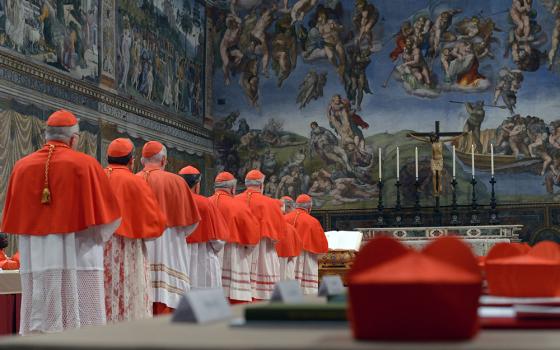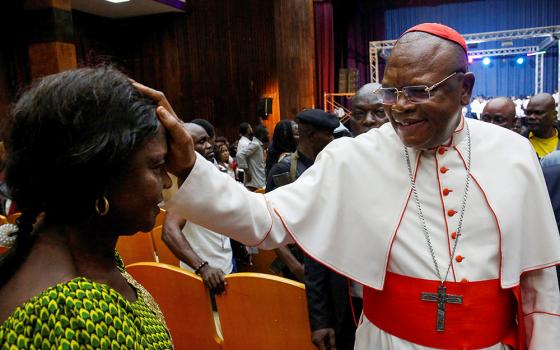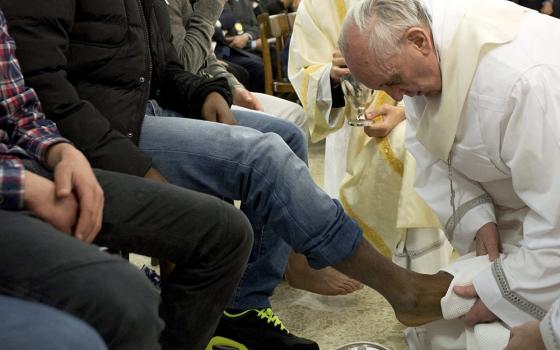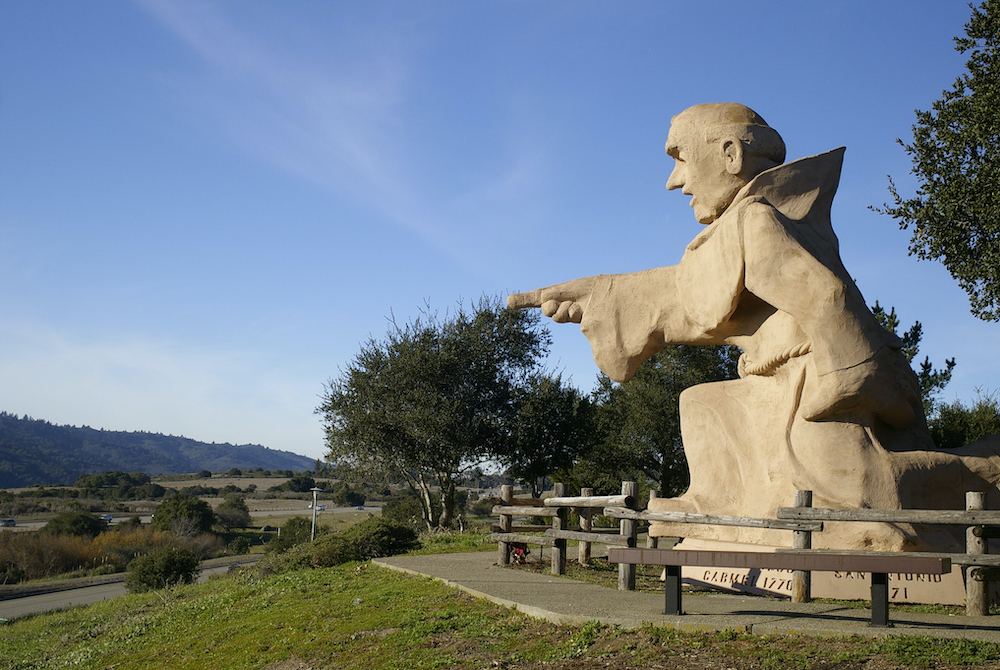
A 26-foot-tall concrete statue of Junípero Serra in Hillsborough, California, points west over I-280 toward the Crystal Springs Reservoir. (Flickr/Mike Fernwood)
San Gabriel, California, residents Lucille Aguirre and her son, Dan, look mournfully at the Mission San Gabriel Arcángel, which was severely damaged by a fire July 11. The Aguirres have deep family roots at the mission and ancestors buried in the cemetery grounds. (Ian Vergara)
Andrew Galvan, curator at the Old Mission Dolores in San Francisco, has always felt a deep spiritual connection to Fr. Junípero Serra. He was present in Rome when Serra was beatified by St. John Paul II in 1988, and 27 years later in 2015 he was in Washington, D.C., when the Spanish Franciscan friar was canonized a saint by Pope Francis.
"It was one of those 'somebody pinch me' moments," said Galvan, a direct descendant of the Ohlone, Bay Miwok, Plains Miwok and Patwin Indian tribes in the Bay Area, who helped promote Serra's sainthood cause. "Junípero Serra is as alive to me today as he was to my ancestors in the California missions 250 years ago."
Galvan is part of a movement of people speaking out in defense of Serra — local Catholics, Indigenous peoples, and those who work with and in the missions who support the 18th-century priest who founded the California mission system and converted thousands of natives to Christianity.
The way Serra did this is a long-standing subject of debate.
Advertisement
Indigenous activists are confronting what they deem as California's racist past, calling for the removal of colonial-era monuments, including statues of Serra. Years after his controversial canonization, Serra's name has reappeared in headlines, amid national protests of systemic racism and the resurgence of the Black Lives Matter movement. Since June, several prominent statues of Serra have been defaced or toppled over by protestors in Los Angeles, San Francisco and Sacramento, echoing past incidents with statues in Monterey, Santa Barbara and Mission San Gabriel.
Some of California's oldest missions have also moved some of their Serra statues from the public eye, out of precaution.
Activists criticize Serra's role in "civilizing" California's original residents, Native Americans, for whom the missions were built. They said Native peoples were coerced into the missions to be baptized, but instead were beaten, sickened with disease and forced into labor — all part of the mission system as supervised by Serra, who helped establish the state's first nine missions until his death in 1784.
Some commentators have called Serra, who is often regarded as "the founding father of California," a "brutal colonialist."
A mural outside the San Gabriel Mission Church, located on the original mission property in San Gabriel, California, depicts a Franciscan missionary baptizing an indigenous person at the mission site. (Ian Vergara)
For years, Native American groups and advocates have openly called against his sainthood. One group in Sacramento is attempting to "de-Serra" the city, calling his statues "monuments to racism and genocide." In Father Serra Park in downtown Los Angeles, indigenous activists behind the June 20 toppling of his statue said they wanted "all sides" of the story told, "not just for us, but for future generations."
Even fellow Franciscans have been grappling with Serra's controversial legacy, while recognizing the Catholic Church's imperfect past, especially when it came to the work of evangelization.
As a founding member of the California Missions Foundation, Galvan understands the controversial history behind California's 21 missions and their founder. He argues the recent defacing, destroying and removing of Serra's statues is not the answer.
"How can we possibly judge what happened in late 18th-century California using our 21st-century standards? That's what's happening when we talk about Junípero Serra and the California missions," he said. "I don't like Fr. Serra being defaced, but the Serra I know would say that if I'm the problem, then take my statue down. Don't let me be the roadblock to people coming into these missions. …We're talking about how native people were treated during the mission period. But how are these people being treated at the missions today, in 2020?"
California's bishops have spoken out defending the Spanish saint.
In a joint statement, the California Catholic Conference said that while it fully supports "eliminating racism against members of the African-American and Native-American communities," in tearing down Serra statues, protestors "have failed" to "be truly effective as a remedy for racism," as Serra worked "against an oppression that extends far beyond the mission era."
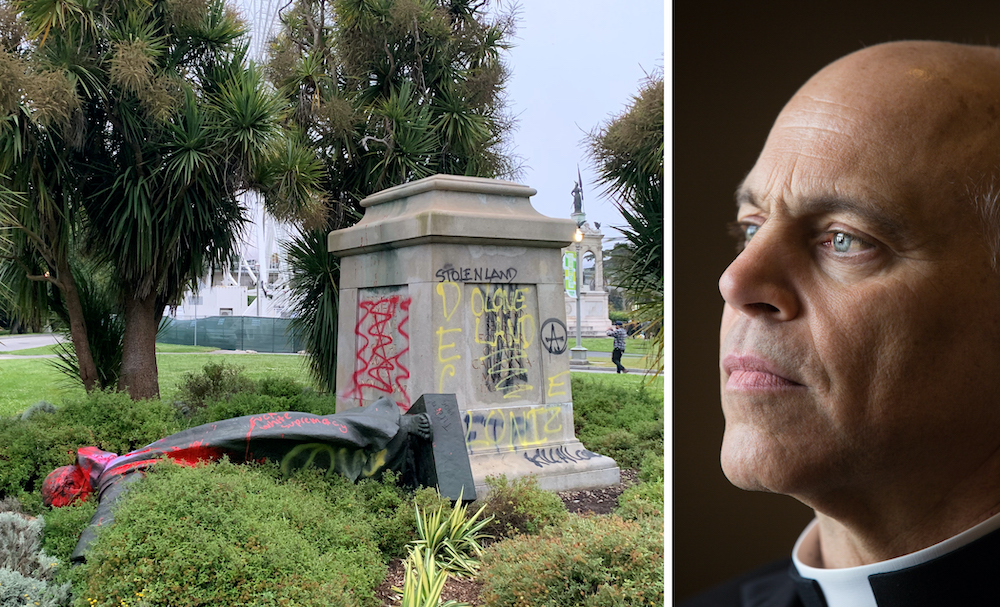
Left: A statue of Junípero Serra statue that was toppled June 19, in Golden Gate Park (CNS/Reuters/David Zandman; Right: San Francisco Archbishop Salvatore Cordileone (CNS/St. Louis Review/Lisa Johnston)
Los Angeles Archbishop José Gomez addressed the controversy in a letter to the faithful: "It is clear that those attacking St. Junípero's good name and vandalizing his memorials do not know his true character or the actual historical record. The sad truth is that, beginning decades ago, activists started 'revising' history to make St. Junípero the focus of all the abuses committed against California's indigenous peoples."
San Francisco Archbishop Salvatore Cordileone visited Golden Gate Park — where a 113-year-old statue of Serra was torn down by protestors June 19 — to offer prayers and perform an exorcism against the "acts of sacrilege" done there.
But Jonathan Cordero, a Ramaytush Ohlone-Chumash activist and professor of sociology at California Lutheran University, wants the church to tell the whole truth of what happened in the missions.
Cordero, the chairperson of the Association of Ramaytush Ohlone, has ancestors who were part of the Missions Santa Barbara and Mission Dolores. He says his role as an activist and teacher is to get truthful information out there and for people, Catholics and Indigenous included, to start asking questions, challenging "automatic church propaganda."
On his website, Cordero has written public responses to the statements by Cordileone and Gomez, arguing that the church's "persistent use of talking points reinforces the romantic myth of the missions that has and continues to inhibit justice for California's Native peoples."
He states that conversions were not genuine, but forced, and that church information is not supported historically. Rather, he says, it's a "fantasy heritage," a way for white Europeans coming into California to "find places of concordance, so they can tie themselves to an imagined past."
"If you honor someone for founding something, then that thing has to have been successful. Were the California missions successful? If they were, we can praise Serra for that," Cordero told NCR. "The church needs to scrutinize the record. You have to weigh the very few who were converted versus the many more who died an untimely death — because of austere working conditions and disease the Spaniards brought — measured against the few who were, maybe, genuinely converted."
The biggest injustice is the retelling of the "mission-commune" myth, Cordero says.
"That myth gets retold because it serves the interest of Christians and white folks. But if it was found out that [the missions] are on stolen land from native people, maybe they'd have to confront that and maybe do something about it. This results in the legacy of poverty and lack of access to healthcare and education for Native Americans that's still happening today."
When it comes to erasing past mistakes or healing the pain of his people, Cordero says, "there is nothing the church, Serra or the missionaries did that outweighs or justifies the loss of land, culture, language, people."
Serra's point of view
Bob Senkewicz, a history professor at Santa Clara University — home to California's eighth mission — argues that "revised" church and U.S. history in the 19th and 20th centuries affects how Serra is viewed today.
"Over time, there have been two very different interpretations of Serra: this heroic man without any faults, versus this brutal colonial oppressor. What we try to do, as historians, is say that neither of them is a complete picture," said Senkewicz, who co-authored, with Rose Marie Beebe, the biography Junípero Serra: California, Indians, and the Transformation of a Missionary.

Statue of Junípero Serra on the grounds of the San Diego Mission (Janet Bartel)
Born in Mallorca, Spain, Serra entered the Franciscans at age 16. As an adult, he came to what Europeans called the New World in 1750 to teach and work with the early Spanish missions in Baja, California, and later moved north to establish the first nine missions in Alta California under Spanish rule. He led the missions for 15 years before his death, with Franciscan friar Francisco Palóu as his right hand.
At the height of the mission era, Serra became a well-known symbol of Spanish California and of colonialism in the developing West, even long after the mission system ended.
Senkewicz points out a key difference in the way this story is told: a focus on Spanish colonialism, versus the work of Christian missionaries like the Franciscans. Though all were working under the Spanish crown to colonize the region, the soldiers typically viewed indigenous people as "inferior." They worked in nearby presidios (barracks) and were in charge of enforcing mission life, often harshly, while the mission priests and friars jobs were to baptize and protect natives from exploitation.
"The missionaries were a part of the Spanish colonialism in Alta [Northern] California, but that system was not one thing only. It had its harsh side, but the missionaries tried to construct a softer side. They believed Indians had souls and were worthy of baptism. That's why missions were constructed … they were enclosed spaces to protect natives from the brutal oppression of the conquistadores and Spanish soldiers. In California, sometimes that worked, and other times it didn't."
Senkewicz added that "harsh coercion" and punishment for crimes was "inevitably part of the mission system," even as the system evolved decades after Serra's death. But, he pointed out, there is no evidence that Serra, as the head of it all, had anything to do with it himself. Yet critics and civil rights activists began to paint the religious missions as concentration camps, the treatment of natives as genocide, and Serra as their "grisly architect."
"As the brutality and number of deaths became more widely known [in the 20th century], Serra became a symbol of coercion and violence, which in his own life, was not there very much at all," he said.
The Mission San Gabriel Arcángel in San Gabriel, California, is the fourth mission established by the Spanish Franciscan Friar Junípero Serra in 1771. The mission removed its statue of Serra shortly after protests surrounding the controversy around how Native Americans were treated at the missions. The nearly 250-year-old original building suffered major damage in a fire on July 11. (Ian Vergara)
In his research, Senkewicz looked at some of the primary sources: letters, reports and diary entries Serra wrote about his experiences in the early missions, including at Missions San Diego and Carmel.
"[Serra] was very aware that in order to preach the Gospel and to be a missionary, what you try to do is understand the spirituality, the beliefs, the folkways, the theology these people have, and you try to find elements which you can use as bridges of introducing Christianity," Senkewicz said.
"That's what missionaries do," he added, "figure out where people are, and how to use that to bring others to a fuller understanding, and eventual acceptance, of Catholicism."
Historians agree that mission history was far from perfect, and corporal punishment, no matter who was behind it, was still evident.
Msgr. Francis J. Weber, an archivist emeritus for the Archdiocese of Los Angeles, wrote that California's colonization in the late 18th century was "inevitable," and that the missionaries were aware of the abuses — which were standard means of correction at the time — but their aim was to change them for the better.
"The missionaries were not unmindful of history; they voluntarily became part of the process in order to Christianize and to cushion what they knew would be a major cultural shock," he said.
"We have to be very careful not to fall into the fallacy of judging the past with present attitudes. While corporal punishment is relatively uncommon in modern times, the use of the lash, stocks and shackles, for example, were commonplace among civilized people in many parts of the world in the 18th century," Weber added. "The attitude of the friars toward corporal punishment can only be properly understood within their overall relationship as 'guardians' of the natives. Serra understood this in terms of education within a family, recognizing that a friar was to treat the Indians 'as a tender and prudent father.' "
Being in charge of an imperfect system also proved Serra's humanness, as well as his sainthood, he said.
"When the church is canonizing somebody, they're not saying they are perfect. They're saying this person had certain virtues that we think the faithful can emulate," Senckewicz said. "But Pope [Francis] is not saying that Serra was perfect or that the missions were perfect. They weren't. If you had to be perfect to be canonized, no one would be canonized."
A way forward with forgiveness
Indigenous educators and advocates, including Galvan and Cordero, have long fought for classrooms to reimagine the "rosy, romanticized" picture of Spanish California in the mission era, which often portrays missions full of happy padres and docile, working natives.
Deacon Andy Orosco, a Kumeyaay tribal member from the San Pasqual Band of Mission Indians in San Diego, talks often to other tribal members about mission history in hopes of moving toward healing.
"Native American ministry has always been near and dear to my heart … but it's a ministry that is hurting. The people have a great bitterness in their heart," Orosco shared. "At one time most of us were Catholic, but started falling away within the last 50 years. Many natives have been 'wokened,' and not in a good way."
Orosco serves in the Office for Native American Ministry for the Diocese of San Bernardino, which includes 15 local Indian reservations. He has Kumeyaay and Tongva ancestral ties in two Southern California missions, San Diego and San Gabriel, and is the only ordained Native American deacon in San Bernardino, San Diego and Los Angeles regions.
He argues that history has "convoluted Fr. Serra's story with the secularization of Mexico and the state of California," much later after Serra's death. "The state was a lot more brutal on natives than Fr. Serra was," Deacon Orosco said.
"People [destroying statues, missions] think they are hurting Fr. Serra, when he is already in heaven. Those statues are just stone, wood, bronze. The purpose of monuments is to represent a moment in time, a person in history. As far as I'm concerned, Serra was a good man of his time. I don't think he was working to 'get a statue' — he probably would have knocked down the first one."
Orosco said that he was moved by Francis' apology to all indigenous peoples during Serra's canonization in 2015. Since then, the deacon has talked extensively with tribal chairmen, elders and leaders in the church about how to better welcome Native American Catholics — as well as their cultural traditions — to the table.
Representation and acknowledgement of past sins, the deacon said, is the only way to move forward.
"Our people have been here for 10,000 years, and Native Catholics are still very much present and alive today," he said. "The church knows that there is hurt out there, there is a deep bitterness, and [we] want to address and heal it. That's what our church does best … forgiveness."
As California continues to wrestle with its ugly past, the way local Catholics, leaders, missions and schools respond to the abuse and controversy can shape how the nation will move forward for the future.
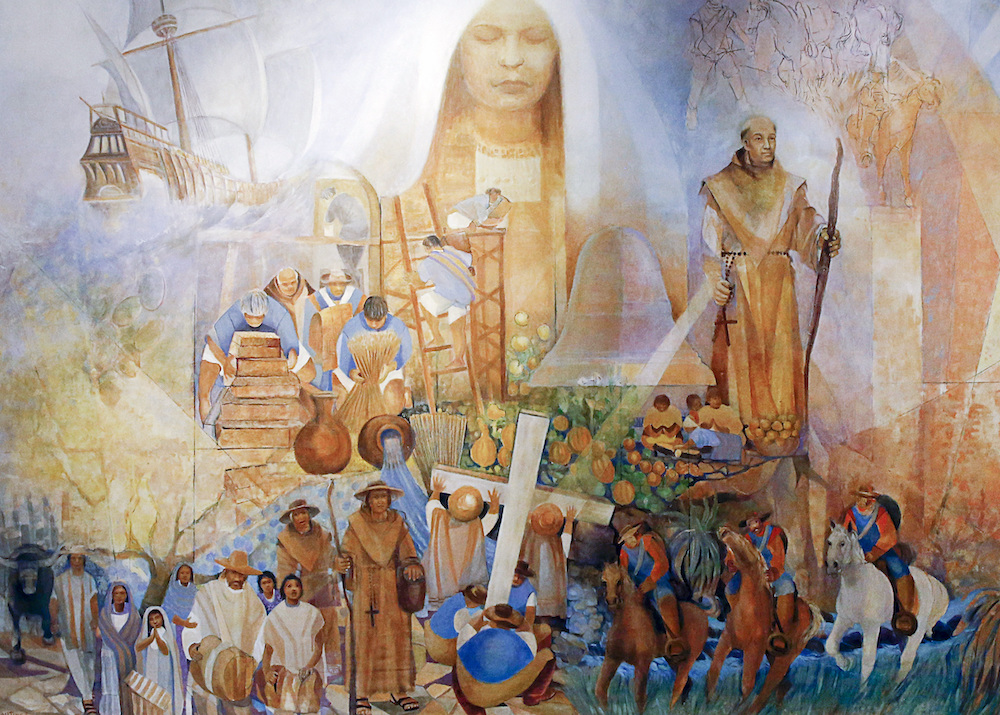
A mural depicting emerging Catholicism in North America by Frank A. Martinez is at the entrance of the Cathedral of Our Lady of the Angels in Los Angeles. The rendering depicts figures from early 18th-century California, including St. Junípero Serra, right, and native people building the missions and harvesting crops. The central figure at the top is Mary. (CNS/Nancy Wiechec)
Though not the original agrarian, baptizing outposts Serra established in his time, many of today's existing missions have been converted into museums honoring their indigenous past, or into pilgrimage sites or parishes/mission schools with diverse, thriving communities.
Galvan, the curator at San Francisco's Old Mission Dolores, led the 2015 Catholic school curriculum review and mission cultural study with the California Catholic Conference. He sees this historical shift as "an opportunity for the church to continue to grow, as Serra would want it."
"He wouldn't be pleased with the violence and vandalism. But he would talk about how [the church] could revamp itself to be more inviting and welcoming to all peoples. Times have changed, so we have to be a church that responds to the needs of the people of the 21st century."
When activists suggest putting up statues of California's indigenous, rather than erecting colonizers, Galvan — and other indigenous Catholics and leaders — offer a more practical, long-lasting approach. He would rather see the effort go toward having respectful dialogue, freely welcoming Native Americans into the missions and church, changing the way the mission system (and the story of Serra) is taught in schools, and fundraising scholarships for Native youth to attend college.
"I would like to see this fire keep going … an outreach and active response of Native Indians returning to the missions. I want the bishops and the church to open the doors, and for native people to respond to the invitation to come back in," Galvan said.
"That's what I think Fr. Serra would like to see happen today. He would be the guy out there, carrying the banner, saying to follow him," he continued. "We have nothing to fear by telling the truth of the California missions. They are places of healing and survival, living histories [that] our ancestors built. Rather than boarding up places, let's open the doors."
[Allyson Escobar is a journalist from the greater Los Angeles area and a graduate of the City University of New York's journalism school. Her work has appeared in national and Catholic publications including NBC News, the Los Angeles Times, America Magazine, The Tablet and Angelus News.]


